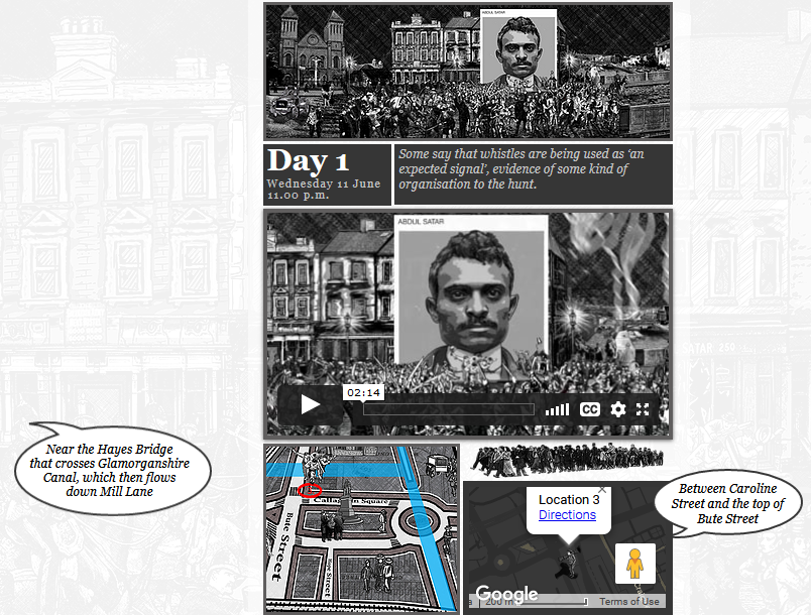Seminar Blogs
“Cardiff 1919 Riots Redrawn: Morphing Newspapers into Lively Knowledge” – Eleonora Stacchioti
In the last session organized by the research group Transmission in Motion, we had the pleasure to delve into the work of Mike Pearson, Professor in Performance Studies at Aberystwyth University and brilliant theatre maker.
He presented Cardiff 1919, Riots Redrawn, a graphic novel by artist Kyle Legall, which results to be a narrative depiction of the detailed and realistic reconstruction based on true facts that took place for four days in June 1919 in the Welsh capital city. Mike Pearson, who defines himself as an expert in archaeology and performance, with his team of artists, scholars, and specialists, realized a multifarious project that aims at the diffusion and the sharing of a chapter of the city’s history that needs to be spoken about. The audience of the TiM session experienced this creation in a double format: first, we were asked to look at the digital graphic novel available online, then Mike performed an oral narration of the facts during the video call. Using a set of different media (mainly maps, animations, and drawings based and drawn from historical documents and accounts), the digital experience is directly addressing the possibility to “come back to [it] again and again” as a way to “delve deeper into this moment of history” or to “download the map to connect” the past to the present-day locations (quoting from the website).
Mike, accompanied by a huge amount of visual material from the past and pictures from 21st century’s Cardiff, read a detailed chronicle of the facts on our screens and made us travel in time and space to reach the dimension where linearity is just a “reference point” and not the basic quality of time. The image I just used wants to give my readers a taste of what, as a spectator, I witnessed on the 16th of December: by the reworking of the facts as found in newspapers, Cardiff 1919 is not only entertaining but is catchy and relevant for me, a person who has never been to Cardiff and that will probably never go in the next few years. What they did is the creation of a relatability to the events through the artistic and performative manipulation of the content that one could find in a history book.

Even if history is not my main research interest, virtual participation in these two forms of digital narration made me reflect on the possibilities given by new media to reformulate history into enjoyable cultural products. This reminded me of what Cultural Memory Studies researcher Ann Rigney acknowledges as the fundamental qualities of a piece of (literary) art: mobility and morphing. In her essay “The Dynamics of Remembrance: Texts Between Monumentality and Morphing” she analyses the inherent dynamics of the selection and the transmission of certain figures of memory (2008, 345) within the realm of cultural practices in the making of identity construction. She argues that the only figures of memory that keep living through the years are those that are at the same time monumental – in the sense that they inherently carry reference points in history and/or art – and able to undergo to processes of morphing (Rigney 2008, 349), among which I put adaptations from one medium to the other, translation from one language to another. Only the “cultural objects” that are suitable for continuous streams of reformulation can resist the inexorable passing of time. Therefore, only the “makers” that morph the archived, forgotten, dusty pages of history can succeed at wider groups of citizens. And Kyle Legall and his colleagues definitely managed to reach their goal.
References
- Rigney, Ann. 2008.“The Dynamics of Remembrance: Texts Between Monumentality and Morphing” in Cultural Memory Studies; An International and Interdisciplinary Handbook, edited by Erll A.Nünning, 345-353. Berlin: Walter de Gruyter Gmbh&Co.
*Image credits: Cardiff 1919: Riots Redrawn’s, screenshot from the online graphic novel by Kyle Legall, available at https://www.cardiff1919.wales/

